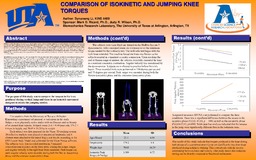
ATTENTION: The works hosted here are being migrated to a new repository that will consolidate resources, improve discoverability, and better show UTA's research impact on the global community. We will update authors as the migration progresses. Please see MavMatrix for more information.
Show simple item record
| dc.contributor.author | Li, Synyoung | |
| dc.date.accessioned | 2017-07-07T22:32:01Z | |
| dc.date.available | 2017-07-07T22:32:01Z | |
| dc.date.issued | 2016 | |
| dc.identifier.uri | http://hdl.handle.net/10106/26869 | |
| dc.description | KINE 4400 | en_US |
| dc.description.abstract | INTRODUCTION: Isokinetic movements occur at a fixed angular velocity, regardless of torque applied by the subject. Isokinetic testing has been correlated with field tests and clinical predictions such as recovery from surgery. Peak torque at a given angular velocity is the most commonly measured variable. Although isokinetic tests are correlated with field tests such as the vertical jump, there is little research comparing the same variables. Three-dimensional motion capture systems can accurately model a subject’s movement. Software then models virtual skeletons based on the anatomical markers captured by the camera system. The virtual reconstruction of the subject provides kinetic and kinematic data of the joints and segments. This system can therefore measure peak torque during common or sport-specific movements. While other studies have demonstrated correlations between isokinetic testing and field tests, this system can directly compare the two.
PURPOSE: The purpose of this study was to compare the torques in the knee produced during vertical jump and those in an isometric movement designed to mimic the jumping motion.
METHODS: Five male students (age: 23.4 ±0.89 years, height: 179.2 ±6.4 cm, weight: 78.05 ±10.29 kg) from the University of Texas at Arlington (UTA) Kinesiology Department volunteered to participate in the study. Each subject was first prepared for the Vicon motion capture system. 26 reflective markers were placed on anatomical landmarks and 4 clusters were attached to the lateral thighs and shanks according to the UTA Lower Body Model. The subjects were calibrated for the Vicon Nexus software. The subjects were then recorded performing three maximal countermovement jumps on the force plate. They then were fitted and introduced to the BioDex for the isokinetic testing. The isokinetic test began with the knee extended. The machine would force the subjects into flexion as the subjects resisted with maximum effort (eccentric contraction). Upon reaching the end of range of motion for flexion, the subjects would re-extend the knee as forcefully as possible (concentric contraction). Subjects were allowed to practice before trials began. Trials were performed three times at 150 degrees per second (d/s) and 75 d/s. For all three conditions, peak torque in the right knee was measured during the flexion (eccentric) phase and extension (concentric) phase. During the jump, peak angular velocity in the right knee was also measured.
RESULTS: The normalized peak torque during the eccentric phase was 3.090 ±0.328 N*m/kg at 75 d/s, 3.025 ±0.399 N*m/kg at 75 d/s, and 1.573 ±0.314 N*m/kg for the jump test. The normalized peak torque during the concentric phase was 2.456 ±0.163 N*m/kg at 75 d/s, 2.130 ±0.082 N*m/kg at 75 d/s, and 0.893 ±0.253 N*m/kg for the jump test. The peak angular velocities were 212.3 ±28.9 d/s in the eccentric phase and 762.6 ±72.7 d/s in the concentric. A repeated measures ANOVA was performed to compare the conditions. There was a significant difference between the means in the eccentric phase: F(2,8) = 61.63, p = .000; there was also a significant difference between the means in the concentric phase: F(2,8) = 27.62, p = .000. Sidak post hoc analysis indicated that the jump torques were different between the isokinetic torques.
CONCLUSION: The results of this study indicate that torques produced in the knee during both phases of a countermovement jump are significantly less than those produced during isokinetic testing. This could be due to the greater angular velocity and the force/velocity relationship. | en_US |
| dc.description.sponsorship | Ricard, Mark D. and Wilson, Judy R. | en_US |
| dc.language.iso | en_US | en_US |
| dc.subject | Isokinetic movements | en_US |
| dc.subject | isometric movement | en_US |
| dc.subject | Torque | en_US |
| dc.subject | Jumping | en_US |
| dc.title | COMPARISON OF ISOKINETIC AND JUMPING KNEE TORQUES | en_US |
| dc.type | Presentation | en_US |
| dc.publisher.department | Department of Kinesiology, The University of Texas at Arlington | en_US |
| dc.publisher.department | Biomechanics Research Laboratory, The University of Texas at Arlington | en_US |
| dc.publisher.department | Exercise Science Research Laboratories, The University of Texas at Arlington | en_US |
Files in this item
- Name:
- Li.pdf
- Size:
- 474.9Kb
- Format:
- PDF
- Description:
- PDF
This item appears in the following Collection(s)
Show simple item record


